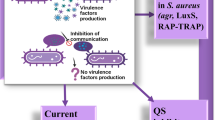Abstract
Staphylococcus aureus uses the agr quorum sensing (QS) system to regulate reciprocally colonisation and virulence factor production. S. aureus strains can be divided into four agr groups: those within a specific agr group activate the QS systems of strains belonging to the same group, while inhibiting agr expression in strains of other groups. Furthermore, agr homologues exist in many more species of Gram-positive bacteria, raising the likelihood of cross-species interference. In principle, a non-pathogenic strain of S. aureus or other species of bacteria employing agr could be engineered to inhibit the QS systems of pathogenic strains using agr, thus down-regulating their production of virulence factors. We present three models of the agr operon belonging to strains competing for dominance, each comprising one of the three possible phosphorylation cascades governing the two component system (TCS) of the agr system. Bifurcation analyses clarify the aspects of QS most crucial in determining the efficacy of using a non-pathogenic strain for therapeutic purposes if the target TCS cascade is known and illustrate the qualitative and quantitative differences which occur as a result of mechanistic differences between the models. We highlight those results that, in concert with appropriate experimental data, would be most useful in ascertaining whether or not a classical TCS is in operation in a particular strain if this information is unknown.
Similar content being viewed by others
References
Atkinson, S., & Williams, P. (2009). J. R. Soc. Interface, 6, 959–978.
Balagaddé, F. K., Song, H., Ozaki, J., Collins, C. H., Barnet, M., Arnold, F. H., Quake, S. R., & You, L. (2008). Mol. Syst. Biol., 4(187), 1–8.
Cisar, E. A. G., Geisinger, E., Muir, T. W., & Novick, R. P. (2009). Mol. Microbiol., 74, 44–57.
Cooksley, C. M., Davis, I. J., Winzer, K., Chan, W. C., Peck, M. W., & Minton, N. P. (2010). Appl. Environ. Microbiol., 76, 4448–4460.
Gustafsson, E., Nilsson, P., Karlsson, S., & Arvidson, S. (2004). J. Mol. Microbiol. Biotechnol., 8, 232–242.
Jabbari, S. (2007). Mathematical modelling of quorum sensing and its inhibition. Staphylococcus aureus, PhD thesis University of Nottingham, UK.
Jabbari, S., King, J. R., Koerber, A. J., & Williams, P. (2010b). J. Math. Biol., 61, 17–54.
Jabbari, S., King, J. R., & Williams, P. (2010a). Math. Biosci., 225, 115–131.
Jabbari, S., King, J. R., & Williams, P. (2011). Bull. Math. Biol. doi:10.1007/s11538-011-9702-0.
Ji, G., Beavis, R., & Novick, R. P. (1997). Science, 276, 2027–2030.
Kambam, P. K. R., Henson, M. A., & Sun, L. (2008). IET Syst. Biol., 2, 33–38.
Koenig, R. L., Ray, J. L., Maleki, S. J., Smeltzer, M. S., & Hurlburt, B. K. (2004). J. Bacteriol., 186, 7549–7555.
McDowell, P., Affas, Z., Reynolds, C., Holden, M. T. G., Wood, S. J., Saint, S., Cockayne, A., Hill, P. J., Dodd, C. E. R., Bycroft, B. W., Chan, W. C., & Williams, P. (2001). Mol. Microbiol., 41, 503–512.
Nealson, K. H., & Hastings, J. W. (1979). Microbiol. Rev., 43, 496–518.
Novick, R. P. (2003). Mol. Microbiol., 48, 1429–1449.
Novick, R. P., Ross, H. F., Projan, S. J., Kornblum, J., Kreiswirth, B., & Moghazeh, S. (1993). EMBO J., 12, 3967–3975.
Ohtani, K., Yuan, Y., Hassan, S., Wang, R., Wang, Y., & Shimizu, T. (2009). J. Bacteriol., 191, 3919–3927.
Otto, M., Süßmuth, R., Vuong, C., Jung, G., & Götz, F. (1999). FEBS Lett., 450, 257–262.
Otto, M., Echner, H., Voelter, W., & Götz, F. (2001). Infect. Immun., 69, 1957–1960.
Podbielski, A., & Kreikemeyer, B. (2004). Int. J. Infect. Dis. , 8, 81–95.
Qazi, S., Middleton, B., Muharram, S. H., Cockayne, A., Hill, P., O’Shea, P., Chhabra, S. R., Cámara, M., & Williams, P. (2006). Infect. Immun., 74, 910–919.
Queck, S. Y., Jameson-Lee, M., Villaruz, A. E., Bach, T. H. L., Khan, B. A., Sturdevant, D. E., Ricklefs, S. M., Li, M., & Otto, M. (2008). Mol. Cell, 32, 150–158.
Riedel, K., Hentzer, M., Geisenberger, O., Huber, B., Steidle, A., Wu, H., Hœiby, N., Givskov, M., Molin, S., & Eberl, L. (2001). Microbiology, 147, 3249–3262.
Riedel, C. U., Monk, I. R., Casey, P. G., Waidmann, M. S., Gahan, C. G. M., & Hill, C. (2009). Mol. Microbiol., 71, 1177–1189.
Salmond, G. P. C., Bycroft, B. W., Stewart, G. S. A. B., & Williams, P. (1995). Mol. Microbiol., 16, 615–624.
Sebaihia, M., Peck, M. W., Minton, N. P., et al. (2007). Genome Res., 17, 1082–1092.
Stock, A. M., Robinson, V. L., & Goudreau, P. N. (2000). Annu. Rev. Biochem., 69, 183–215.
Williams, P., Winzer, K., Chan, W. C., & Cámara, M. (2007). Philos. Trans. R. Soc. B, 362, 1119–1134.
Wuster, A., & Babu, M. M. (2008). J. Bacteriol., 190, 743–746.
Zhang, L., Gray, L., Novick, R. P., & Ji, G. (2002). J. Biol. Chem., 277, 34736–34742.
Zhang, L., Lin, J., & Ji, G. (2004). J. Biol. Chem., 279, 19448–19456.
Author information
Authors and Affiliations
Corresponding author
Rights and permissions
About this article
Cite this article
Jabbari, S., King, J.R. & Williams, P. Cross-Strain Quorum Sensing Inhibition by Staphylococcus aureus. Part 1: A Spatially Homogeneous Model. Bull Math Biol 74, 1292–1325 (2012). https://doi.org/10.1007/s11538-011-9701-1
Received:
Accepted:
Published:
Issue Date:
DOI: https://doi.org/10.1007/s11538-011-9701-1




